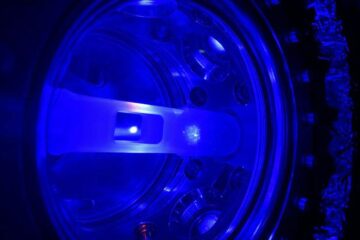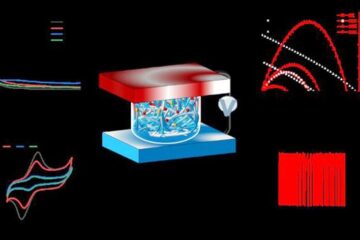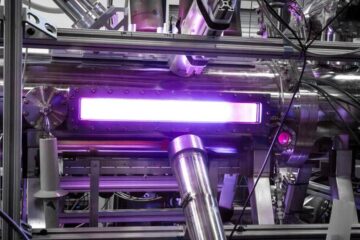MIT's 'electronic nose' could detect explosives, other hazards

Led by MIT professor Harry Tuller, the researchers have devised a way to print thin sensor films onto a microchip, a process that could eventually allow for mass production of highly sensitive gas detectors.
“Mass production would be an enormous breakthrough for this kind of gas sensing technology,” said Tuller, a professor in the Department of Materials Science and Engineering (MSE), who is presenting the research at the Composites at Lake Louise Conference in Alberta, Canada, on Oct. 30.
The prototype sensor, created by Tuller, postdoctoral fellow Kathy Sahner and graduate student Woo Chul Jung, members of MIT's Electroceramics Group in MSE, consists of thn layers of hollow spheres made of the ceramic material barium carbonate, which can detect a range of gases. Using a specialized inkjet print head, tiny droplets of barium carbonate or other gas-sensitive materials can be rapidly deposited onto a surface, in any pattern the researchers design.
The miniature, low-cost detector could be used in a variety of settings, from an industrial workplace to an air-conditioning system to a car's exhaust system, according to Tuller. “There are many reasons why it's important to monitor our chemical environment,” he said.
For a sensor to be useful, it must be able to distinguish between gases. For example, a sensor at an airport would need to know the difference between a toxic chemical and perfume, Tuller said. To achieve this, sensors should have an array of films that each respond differently to different gases. This is similar to the way the human sense of smell works, Tuller explained.
“The way we distinguish between coffee's and fish's odor is not that we have one sensor designed to detect coffee and one designed to detect fish, but our nose contains arrays of sensors sensitive to various chemicals. Over time, we train ourselves to know that a certain distribution of vapors corresponds to coffee,” he said.
In previous work, designed to detect nitrogen oxide (NOx) emissions from diesel exhaust, the researchers created sensors consisting of flat, thin layers of barium carbonate deposited on quartz chips.
However, the films were not sensitive enough, and the team decided they needed more porous films with a larger surface area.
To create more texture, they applied the barium carbonate to a layer of microspheres, hollow balls less than a micrometer in diameter made of a plastic polymer. When the microspheres are burned away, a textured, highly porous layer of gas-sensitive film is left behind.
The resulting film, tens of nanometers (billionths of a meter) thick, is much more sensitive than flat films because it allows the gas to readily permeate through the film and interact with a much larger active surface area.
At first, the researchers used a pipette to deposit the barium carbonate and microspheres. However, this process proved time-consuming and difficult to control.
To improve production efficiency, the researchers took advantage of a programmable Hewlett Packard inkjet print head located in the MIT Laboratory of Organic Optics and Electronics. The inkjet print head, like that in a regular inkjet printer, can deposit “ink” very quickly and controllably. The special gas sensitive inks used in this work were optimized for “printing” by Amy Leung, an MIT sophomore in chemical engineering.
This allows the researchers to rapidly produce many small, identical chips containing geometrically well-defined gas-sensing films with micrometer dimensions. Patterns, of different gas sensitive inks, just as in a color printer, can be easily generated to form arrays with very little “ink” required per sensor.
In future studies, the team hopes to create large arrays of gas sensitive films with controlled three-dimensional shapes and morphologies.
The research is funded by the National Science Foundation.
Media Contact
More Information:
http://www.mit.eduAll latest news from the category: Power and Electrical Engineering
This topic covers issues related to energy generation, conversion, transportation and consumption and how the industry is addressing the challenge of energy efficiency in general.
innovations-report provides in-depth and informative reports and articles on subjects ranging from wind energy, fuel cell technology, solar energy, geothermal energy, petroleum, gas, nuclear engineering, alternative energy and energy efficiency to fusion, hydrogen and superconductor technologies.
Newest articles

Superradiant atoms could push the boundaries of how precisely time can be measured
Superradiant atoms can help us measure time more precisely than ever. In a new study, researchers from the University of Copenhagen present a new method for measuring the time interval,…

Ion thermoelectric conversion devices for near room temperature
The electrode sheet of the thermoelectric device consists of ionic hydrogel, which is sandwiched between the electrodes to form, and the Prussian blue on the electrode undergoes a redox reaction…

Zap Energy achieves 37-million-degree temperatures in a compact device
New publication reports record electron temperatures for a small-scale, sheared-flow-stabilized Z-pinch fusion device. In the nine decades since humans first produced fusion reactions, only a few fusion technologies have demonstrated…





















